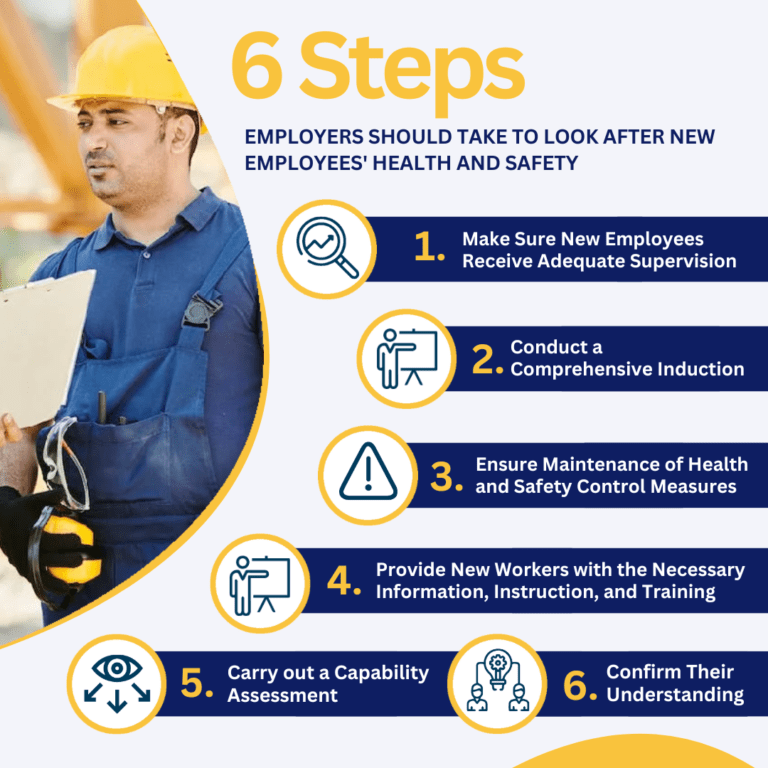Starting a new job can be an exciting and challenging experience. However, research has shown that workers are as likely to have an accident within their first six months at work as they are during the rest of their working life. The reasons behind this increased risk are varied, including lack of experience, unfamiliarity with the job and work environment, reluctance to raise concerns, and the desire to perform well and impress colleagues and managers.
As employers, we are responsible for looking after our new starters and creating a working environment that prioritises their safety. In this blog post, we’re giving you six essential steps to ensure your new workers’ health and safety.

6 Steps Employers Can Take to Look After New Employees’ Health and Safety:
Before new starters begin their roles, it is crucial to assess their capabilities. This assessment should include evaluating their literacy and numeracy levels (if relevant), general health, relevant work experience, and physical ability to perform the job. Additionally, you should consider their familiarity with the work assigned to them and the working environment, particularly in industries with rapidly changing conditions. Cultural issues and language proficiency should also be taken into account, and visual aids such as pictures, signs, or videos can be used to better communicate important information or aspects of the role.
Providing a thorough induction is vital to familiarise new workers with their surroundings and potential risks. Plan the induction carefully, using plain and simple language. Visual aids, such as photos of hazards, can be highly effective in communicating risks. Take the time to walk around the workplace or site with the new worker/s, pointing out major hazards like places where falls and slips could be more likely. This hands-on approach will help new starters better understand the risks they may encounter. These measures can be especially important on work sites that use a lot of manual handling/physical processes, e.g., construction sites, factories, and warehouse work.
- Maintaining Control Measures:
Ensure that control measures to mitigate risks are up to date and properly used and maintained. Engage in discussions with employees and health and safety representatives to address risks and identify the best way to protect new starters. Emphasise the importance of reporting accidents and near misses and make necessary arrangements for health surveillance. It is crucial to provide suitable personal protective equipment (PPE) and ensure its proper maintenance.
When taking on new workers, completing a comprehensive, in-depth risk assessment couldn’t be more important. At OFI, we can conduct risk assessments for you and train members of your team to become your own in-house risk assessors, whether you’re looking for help with:
- Information, Instruction, and Training:
New workers must receive relevant information, instruction, and training about the risks they may face and the precautions they must take to avoid them. Clearly communicate the potential hazards and provide detailed guidance on safety measures. This may include training on the proper use of equipment, manual handling techniques, and workplace safety protocols. Remember to use clear, easy to understand language to ensure comprehension.
At OFI, we’ve been providing our clients with a range of musculoskeletal injury prevention services for over 35 years. We can support you with:
- Manual Handling Training for employees and trainers
- People Moving and Handling Training for employees and trainers
- Ergonomics Training
- DSE (Display Screen Equipment) training
- Adequate Supervision:
New workers require adequate supervision, especially during their initial days and weeks on the job. Supervisors should create an open and supportive environment where workers feel comfortable raising concerns or questions about their work. Recognise that unfamiliarity, inexperience, or new job nerves may make it challenging for new starters to speak up. Encouraging regular communication and providing a clear reporting structure will help foster a workplace culture that prioritises safety.
- Confirm Understanding:
Periodically check new workers’ understanding of the information, instruction, and training they have received. Ensure they are actively applying their knowledge to work safely. During these crucial early stages of employment, confirm that workers know whom to speak to about their health and wellbeing at work, are familiar with the emergency procedures in place, and know how to raise concerns about their health and safety.
Vulnerable Workers:
Certain categories of workers, such as young people and migrant workers, may require additional attention and support during their transition into the workplace.
- Young people: Recognise that younger workers may lack the experience, skills, maturity, and confidence of their older colleagues. You should tailor training and supervision to their specific needs, focusing on the potential risks associated with their roles.
- Migrant workers: Migrant workers can face unique challenges when starting a new job. Ensure that language barriers are addressed and that information, instruction, and training are provided in a language they understand. You should also familiarise yourself with specific guidance for employers of migrant workers to ensure their safety and wellbeing.
To create a healthy, happy workforce, it couldn’t be more important to care for the health and safety of new workers. By following these six steps, we can significantly reduce the risks they face during the crucial period at the beginning of their employment. Remember to assess their capabilities, provide comprehensive inductions, maintain control measures, deliver relevant information and training, offer adequate supervision, and confirm their understanding. By prioritising new workers’ safety, we can create a positive and secure work environment that fosters productivity and wellbeing.
Remember, making a strong commitment to new workers’ health and safety sets a solid foundation for a successful, sustainable, and loyal workforce.
Would you like further guidance on tailoring your health and wellbeing strategy so it better supports the needs of new workers, as well as your existing workforce?
If you’re unsure where to start, our sister company Thrive4Life’s Wellbeing Consultancy services take the confusion out of caring for your employees in the best way possible.
Our team of experienced health and wellbeing professionals will:
- Work with you to identify your organisation’s specific needs.
- Create a strategy that better supports these needs.
- Monitor and evaluate the strategy to ensure long-term success.
References:
- “New to the Job: Health and Safety”, Health and Safety Executive (HSE) – www.hse.gov.uk
- European Agency for Safety and Health at Work (EU-OSHA) – osha.europa.eu








